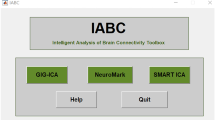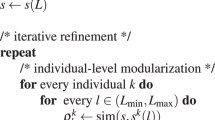Abstract
Functional networks (FNs) hold significant promise in understanding brain function. Independent component analysis (ICA) has been applied in estimating FNs from functional magnetic resonance imaging (fMRI). However, determining an optimal model order for ICA remains challenging, leading to criticism about the reliability of FN estimation. Here, we propose a SMART (splitting-merging assisted reliable) ICA method that automatically extracts reliable FNs by clustering independent components (ICs) obtained from multi-model-order ICA using a simplified graph while providing linkages among FNs deduced from different-model orders. We extend SMART ICA to multi-subject fMRI analysis, validating its effectiveness using simulated and real fMRI data. Based on simulated data, the method accurately estimates both group-common and group-unique components and demonstrates robustness to parameters. Using two age-matched cohorts of resting fMRI data comprising 1,950 healthy subjects, the resulting reliable group-level FNs are greatly similar between the two cohorts, and interestingly the subject-specific FNs show progressive changes while age increases. Furthermore, both small-scale and large-scale brain FN templates are provided as benchmarks for future studies. Taken together, SMART ICA can automatically obtain reliable FNs in analyzing multi-subject fMRI data, while also providing linkages between different FNs.








Similar content being viewed by others
References
Zhao B, Li T, Smith SM, Xiong D, Wang X, Yang Y. Common variants contribute to intrinsic human brain functional networks. Nat Genet 2022, 54: 508–517.
Zanin M. Simplifying functional network representation and interpretation through causality clustering. Sci Rep 2021, 11: 15378.
Chen Y, Tang JH, de Stefano LA, Wenger MJ, Ding L, Craft MA, et al. Electrophysiological resting state brain network and episodic memory in healthy aging adults. Neuroimage 2022, 253: 118926.
Chong JSX, Ng KK, Tandi J, Wang C, Poh JH, Lo JC, et al. Longitudinal changes in the cerebral cortex functional organization of healthy elderly. J Neurosci 2019, 39: 5534–5550.
Váša F, Romero-Garcia R, Kitzbichler MG, Seidlitz J, Whitaker KJ, Vaghi MM, et al. Conservative and disruptive modes of adolescent change in human brain functional connectivity. Proc Natl Acad Sci U S A 2020, 117: 3248–3253.
Du Y, He X, Kochunov P, Pearlson G, Hong LE, van Erp TGM, et al. A new multimodality fusion classification approach to explore the uniqueness of schizophrenia and autism spectrum disorder. Hum Brain Mapp 2022, 43: 3887–3903.
Qian X, Castellanos FX, Uddin LQ, Loo BRY, Liu S, Koh HL, et al. Large-scale brain functional network topology disruptions underlie symptom heterogeneity in children with attention-deficit/hyperactivity disorder. Neuroimage Clin 2019, 21: 101600.
Khatri U, Kwon GR. Alzheimer’s disease diagnosis and biomarker analysis using resting-state functional MRI functional brain network with multi-measures features and hippocampal subfield and amygdala volume of structural MRI. Front Aging Neurosci 2022, 14: 818871.
Li X, Zhang K, He X, Zhou J, Jin C, Shen L, et al. Structural, functional, and molecular imaging of autism spectrum disorder. Neurosci Bull 2021, 37: 1051–1071.
Yang J, Gohel S, Vachha B. Current methods and new directions in resting state fMRI. Clin Imaging 2020, 65: 47–53.
Wang Z, Xin J, Wang Z, Yao Y, Zhao Y, Qian W. Brain functional network modeling and analysis based on fMRI: A systematic review. Cogn Neurodyn 2021, 15: 389–403.
Patil AU, Madathil D, Huang CM. Healthy aging alters the functional connectivity of creative cognition in the default mode network and cerebellar network. Front Aging Neurosci 2021, 13: 607988.
Du Y, Guo Y, Calhoun VD. Aging brain shows joint declines in brain within-network connectivity and between-network connectivity: A large-sample study (N > 6, 000). Front Aging Neurosci 2023, 15: 1159054.
Du Y, Fu Z, Sui J, Gao S, Xing Y, Lin D, et al. NeuroMark: An automated and adaptive ICA based pipeline to identify reproducible fMRI markers of brain disorders. Neuroimage Clin 2020, 28: 102375.
Bi XA, Zhao J, Xu Q, Sun Q, Wang Z. Abnormal functional connectivity of resting state network detection based on linear ICA analysis in autism spectrum disorder. Front Physiol 2018, 9: 475.
Rabany L, Brocke S, Calhoun VD, Pittman B, Corbera S, Wexler BE, et al. Dynamic functional connectivity in schizophrenia and autism spectrum disorder: Convergence, divergence and classification. Neuroimage Clin 2019, 24: 101966.
Rai S, Griffiths KR, Breukelaar IA, Barreiros AR, Chen W, Boyce P, et al. Default-mode and fronto-parietal network connectivity during rest distinguishes asymptomatic patients with bipolar disorder and major depressive disorder. Transl Psychiatry 2021, 11: 547.
Gu Y, Li L, Zhang Y, Ma J, Yang C, Xiao Y, et al. The overlapping modular organization of human brain functional networks across the adult lifespan. Neuroimage 2022, 253: 119125.
Xu J, Calhoun VD, Worhunsky PD, Xiang H, Li J, Wall JT, et al. Functional network overlap as revealed by fMRI using sICA and its potential relationships with functional heterogeneity, balanced excitation and inhibition, and sparseness of neuron activity. PLoS One 2015, 10: e0117029.
Li YO, Adali T, Calhoun VD. Estimating the number of independent components for functional magnetic resonance imaging data. Hum Brain Mapp 2007, 28: 1251–1266.
Fu GS, Anderson M, Adalı T. Likelihood estimators for dependent samples and their application to order detection. IEEE Trans Signal Process 2014, 62: 4237–4244.
Cordes D, Nandy RR. Estimation of the intrinsic dimensionality of fMRI data. Neuroimage 2006, 29: 145–154.
Beckmann CF, Smith SM. Probabilistic independent component analysis for functional magnetic resonance imaging. IEEE Trans Med Imaging 2004, 23: 137–152.
Seghouane AK, Shokouhi N. Consistent estimation of dimensionality for data-driven methods in fMRI analysis. IEEE Trans Med Imaging 2019, 38: 493–503.
Hui M, Li J, Wen X, Yao L, Long Z. An empirical comparison of information-theoretic criteria in estimating the number of independent components of fMRI data. PLoS One 2011, 6: e29274.
Kuang LD, Lin QH, Gong XF, Cong F, Sui J, Calhoun VD. Model order effects on ICA of resting-state complex-valued fMRI data: Application to schizophrenia. J Neurosci Methods 2018, 304: 24–38.
Hu G, Waters AB, Aslan S, Frederick B, Cong F, Nickerson LD. Snowball ICA: A model order free independent component analysis strategy for functional magnetic resonance imaging data. Front Neurosci 2020, 14: 569657.
Meng X, Iraji A, Fu Z, Kochunov P, Belger A, Ford J, et al. Multimodel order independent component analysis: A data-driven method for evaluating brain functional network connectivity within and between multiple spatial scales. Brain Connect 2022, 12: 617–628.
Calhoun VD, Liu J, Adali T. A review of group ICA for fMRI data and ICA for joint inference of imaging, genetic, and ERP data. Neuroimage 2009, 45: S163–S172.
Calhoun VD, Adali T, Pearlson GD, Pekar JJ. A method for making group inferences from functional MRI data using independent component analysis. Hum Brain Mapp 2001, 14: 140–151.
Du Y, Fan Y. Group information guided ICA for fMRI data analysis. Neuroimage 2013, 69: 157–197.
Amari S, Cichocki A, Yang HH. A new learning algorithm for blind signal separation. In: Neural Information Processing Systems. Denver: ACM, 1995: 757–763.
Bell AJ, Sejnowski TJ. An information-maximization approach to blind separation and blind deconvolution. Neural Comput 1995, 7: 1129–1159.
Himberg J, Hyvarinen A. Icasso: software for investigating the reliability of ICA estimates by clustering and visualization. 2003 IEEE XIII Workshop on Neural Networks for Signal Processing. Toulouse, France. IEEE, 2003: 259–268.
Bai L, Liang J, Du H, Guo Y. A novel community detection algorithm based on simplification of complex networks. Knowl Based Syst 2018, 143: 58–64.
Lei J, Jiang T, Wu K, Du H, Zhu G, Wang Z. Robust K-means algorithm with automatically splitting and merging clusters and its applications for surveillance data. Multimed Tools Appl 2016, 75: 12043–12059.
Matas J, Chum O, Urban M, Pajdla T. Robust wide-baseline stereo from maximally stable extremal regions. Image Vis Comput 2004, 22: 761–767.
Khosravi MH, Hassanpour H. Image quality assessment using a novel region smoothness measure. J Vis Commun Image Represent 2019, 60: 217–228.
Nistér D, Stewénius H. Linear time maximally stable extremal regions. In: Computer Vision–ECCV 2008. Berlin: Springer, 2008: 183–196.
Du Y, Allen EA, He H, Sui J, Wu L, Calhoun VD. Artifact removal in the context of group ICA: A comparison of single-subject and group approaches. Hum Brain Mapp 2016, 37: 1005–1025.
Griffanti L, Douaud G, Bijsterbosch J, Evangelisti S, Alfaro-Almagro F, Glasser MF, et al. Hand classification of fMRI ICA noise components. Neuroimage 2017, 154: 188–205.
Beckmann C, MacKay C, Filippini N, Smith S. Group comparison of resting-state FMRI data using multi-subject ICA and dual regression. Neuroimage 2009, 47: S148.
Kam TE, Zhang H, Shen D. A novel deep learning framework on brain functional networks for early MCI diagnosis. MICCAI 2018: 21st International Conference, Granada, Spain, September 16–20, 2018, Proceedings, Part III 11 2018: 293–301.
Erhardt EB, Allen EA, Wei Y, Eichele T, Calhoun VD. SimTB, a simulation toolbox for fMRI data under a model of spatiotemporal separability. Neuroimage 2012, 59: 4160–4167.
Allen NE, Sudlow C, Peakman T, Collins R, UK Biobank. UK biobank data: Come and get it. Sci Transl Med 2014, 6: 2244.
Wei P, Bao R, Fan Y. Comparing the reliability of different ICA algorithms for fMRI analysis. PLoS One 2022, 17: e0270556.
Abou-Elseoud A, Starck T, Remes J, Nikkinen J, Tervonen O, Kiviniemi V. The effect of model order selection in group PICA. Hum Brain Mapp 2010, 31: 1207–1216.
Hinton GE, Roweis S. Stochastic neighbor embedding. In: Neural Information Processing Systems 2002: 857–864.
Van der Maaten L, Hinton G. Visualizing data using t-SNE. J Mach Learn Res 2008, 9: 2579–2605.
Jacobs RA. Increased rates of convergence through learning rate adaptation. Neural Netw 1988, 1: 295–307.
Rolls ET, Huang CC, Lin CP, Feng J, Joliot M. Automated anatomical labelling atlas 3. Neuroimage 2020, 206: 116189.
Varangis E, Habeck CG, Razlighi QR, Stern Y. The effect of aging on resting state connectivity of predefined networks in the brain. Front Aging Neurosci 2019, 11: 234.
Geerligs L, Maurits NM, Renken RJ, Lorist MM. Reduced specificity of functional connectivity in the aging brain during task performance. Hum Brain Mapp 2014, 35: 319–330.
Wang L, Li Y, Metzak P, He Y, Woodward TS. Age-related changes in topological patterns of large-scale brain functional networks during memory encoding and recognition. Neuroimage 2010, 50: 862–872.
Acknowledgments
This work was supported by the National Natural Science Foundation of China (62076157 and 61703253), the Fund Program for the Scientific Activities of Selected Returned Overseas Professionals in Shanxi Province (20210033), and the National Institutes of Health (R01MH123610 and R01EB006841).
Author information
Authors and Affiliations
Corresponding author
Ethics declarations
Conflict of interest
The authors report no competing interests.
Supplementary Information
Below is the link to the electronic supplementary material.
Rights and permissions
Springer Nature or its licensor (e.g. a society or other partner) holds exclusive rights to this article under a publishing agreement with the author(s) or other rightsholder(s); author self-archiving of the accepted manuscript version of this article is solely governed by the terms of such publishing agreement and applicable law.
About this article
Cite this article
He, X., Calhoun, V.D. & Du, Y. SMART (Splitting-Merging Assisted Reliable) Independent Component Analysis for Extracting Accurate Brain Functional Networks. Neurosci. Bull. (2024). https://doi.org/10.1007/s12264-024-01184-4
Received:
Accepted:
Published:
DOI: https://doi.org/10.1007/s12264-024-01184-4




